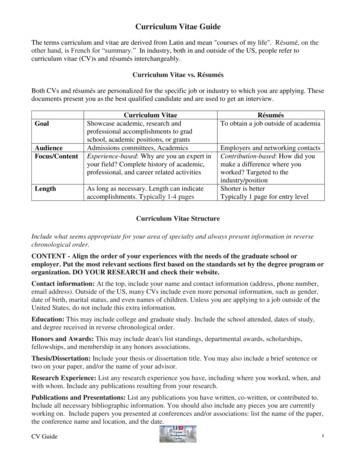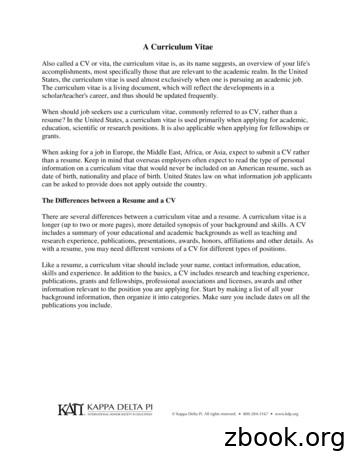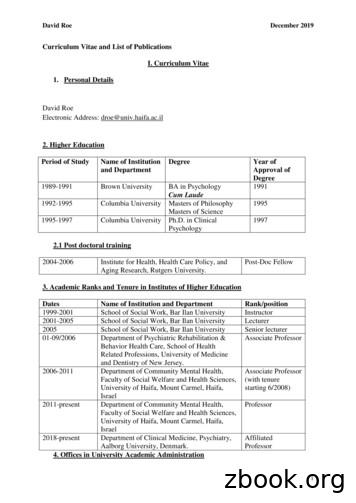Curriculum Vitae (C.V.) Writing Guide
Curriculum Vitae (C.V.)Writing Guide:Developing a Professional SummaryPrepared by:Career DevelopmentStudent LifeMemorial UniversitySt. John’s, NL A1C 5S7(709) 864-2033(709) student
TABLE OF CONTENTSVITAE vs. RESUME2CONTENTPERSONAL INFORMATIONEDUCATIONAL INFORMATIONPROFESSIONAL EXPERIENCEPUBLICATIONS & OTHER CREATIVE WORKSADDITIONAL HEADINGSREFERENCES334455-67VALUE ADDED STATEMENTS8STYLE & PRESENTATION9SAMPLE CURRICULUM VITAE10-12APPENDIX A: Skill Related Action VerbsPrepared by Career Development114
VITAE VS. RESUMEWHAT IS THE DIFFERENCE?A Curriculum Vitae (CV) presents a complete picture of the breadth and depth ofacademic experiences you have accumulated. Your CV is a comprehensivebiographical statement emphasizing professional qualifications, accomplishments andactivities. Graduate students wanting to work as academics, physicians or professionalscan have CV’s that are three to ten pages long. It is used for academic job search orcontinued research, schooling or experience in the academic field. CV's may includelists of your publications, presentations, teaching experiences, honors, grants, anddissertation abstracts.Graduate students should compile what is termed a Professional Summary. Thisconsists of both the CV and résumé. It is very important to know the difference betweenthese two documents and when it is appropriate to use each. A goal of résumé writing isto be brief and concise since, at best, the résumé reader will spend a minute or soreviewing your qualifications. A CV is intended for thorough review and to convey afuller picture of a potential candidate, typically for high ranking positions oropportunities.THE VITAE Comprehensive, 3-5 pages, but can be much longerEmphasizes professional qualifications for application to high-rankingpositionsA CV is best suited for someone with significant professional experience. Thismay include work experience, research, publications, presentations etc. Manyemployers request a CV when they are really expecting a résumé.THE RESUME Brief, 1-2 pagesSummary of skills, qualifications and experience directly relevant to theposition you are applying forRésumés are widely accepted, particularly for entry-level positions and nonacademic fields. They must be scannable, as employers generally read them forless than 15 seconds. While a CV should be concise, it is much more involvedand requires a more thorough review.*Note:For more information see our Resume and Cover Letter reer/careerresources/Resume and Cover Letter Guide 2017.pdfPrepared by Career Development2
THECONTENTWHAT SHOULD I SAY?The following is a list of possible sections that may be included in your C.V. It isnot necessary to use all of these headings; you must always tailor your C.V. toboth your own experience and to the specific position you are applying for. Forexample, if you are moving from a research-based job into a management role,reconsider highlighting “Future Research Interests”. This may give theimpression that you do not want to leave your current placement.Keep in mind that a C.V. is intended to convey a broad view of the potentialcandidate. It should describe your accomplishments in detail, in a way thathighlights your transferable skills (experience that is relevant to differentpositions). For more information see “Value-Added Statements” on page 8.PERSONAL INFORMATION Use your full name and degree initials, e.g. B.Sc, M.Sc.Name should be bolded, centred or to the right or left at the top of the page.Include: current mailing address-home and business (if applicable), contactnumber(s), email-address if you check it regularly.Example:JANE SMITH, B.Ed., M.B.A.Office: Career Development, UC4002Memorial University,St. John’s, NLCanada, A1C 5S7Phone: 555-4567Email: jane.smith@mun.caHome: 123 Drive StreetSt. John’s, NLCanada, CBA 321Phone: 555-1234Prepared by Career Development3
EDUCATIONAL INFORMATION State education in reverse chronological order.All education and training is important and should be included eitherhere or in another section, such as “Additional Education andTraining”.May include details on thesis titles/topics and supervisor (only if directlyrelevant).Example:Master of Business Administration2014– 2016Memorial UniversitySt. John’s, NL Thesis Topic: Major: Minor: Concentration: Any other pertinent information about your education.PROFESSIONAL EXPERIENCE List in reverse chronological order stating: job title, employers’ name,start and end dates, city, province, country.Focus on skills, leadership roles and, areas of particular success orachievement.Start each phrase with an action word, e.g. Conductedpresentations (See “Creating Value-Oriented Statements” on page 8 for moreinformation).Pay special attention to part-time employment that relates to workgoals such as graduate research, teaching, assistantships, etc.When appropriate, create separate categories for part time & full timework.Example:Research AssistantDepartment of Business Administration Developed Analyzed Prepared Maintained Prepared by Career Development42015– 2016St. John’s, NL
Prepared by Career Development5
PUBLICATIONS & OTHER CREATIVE WORKS When appropriate, categorize publications that appeared in refereedor non- refereed journals.Include in this section: publications, presentations, media presentation,inventions (you may create sub-headings for each).For “Publications” show full bibliographic information.If including a partial listing indicate that a full listing is available andstate the cut off date for inclusion.ADDITIONAL HEADINGSAny of the following headings may be included if they are applicable.Always follow a cohesive format throughout your C.V. and place sectionsin descending order of importance (e.g. Education before Affiliations).CompetenciesAssistantshipsAreas of ExperienceAreas of ExpertiseAreas of KnowledgeCertificationsFieldwork/PracticaLanguage CompetencyLicensureProficienciesSpecialized TrainingTeaching/ResearchDistinctionsAcademic AwardsFellowshipsFunded ProjectsGrantsHonors and AwardsLiterary PrizesPatentsResearch AwardsResearch GrantsScholarly SocietiesScholarshipsForeign StudyInternational ProjectsLanguageCompetenciesStudy AbroadTravel AbroadEducation/Academic Academic BackgroundAccomplishmentsAcademic ServiceAcademic TrainingActivities and ed by Career Development6Educational HighlightsEducational OverviewFaculty LeadershipInvited LecturesLectures and ColloquiaMaster's Project
Advisory BoardsAdvisory CommitteesChairmanshipsEducation/Academic Committee rehensive AreasConference LeadershipConferenceParticipationConference PresentationContinuing EducationDissertationOutreachProfessional StudiesPrograms andWorkshopsResearch AppointmentsResearch ExperienceResearch OverviewScholarly PresentationsThesisUniversity AssignmentsUniversity sociationsEndorsementsHonorary SocietiesMembershipsNational BoardsProfessional SocietiesPresentations a RecitalsRefereed Journal ArticlesReviewsScholarly PublicationsTechnical PapersArticles/MonographsBibliographyBook ReviewsBooksConference PapersEditorial AppointmentsEditorial r AchievementsCareer HighlightsConsulting ExperienceExperience HighlightsExperience SummaryProfessionalAchievementsTeachingAcademic InterestsAppointmentsConcentrationsPrepared by Career Development7Professional ActivitiesProfessional BackgroundProfessional ExperienceProfessionalDevelopmentProfessional RecognitionProfessional ServicePostdoctoral ExperienceProfessional OverviewResearch Interests
Course HighlightsTeaching ExperienceCurrent AppointmentsTeaching OverviewCurriculum Development TutorialsInternshipsRetrieved August, 2008, from Sarah Lawrence College, “Sample Headings CV”,http://www.slc.edu/occ/Sample Headings CV.phpREFERENCES References are not required, but if not included indicate “ReferencesAvailable on Request”.If included, list on a separate page attached to the end of your C.V.State references full name, job title, place of employment and contactinformation.Always seek reference’s approval beforehandGive references a copy of your C.V. and the job description of thedesired positionExample:JANE SMITH, B. Ed., M.B.A.Career Development, UC4002Student LifeMemorial University,St. John’s, NL, A1C 5S7Home: 555-1234Office: 555-4567Email: jane.smith@mun.caReferences:John DoeDirector of Business AdministrationMemorial UniversityHome: 555-7891Office: 555-6543Email: j.doe@mun.caPrepared by Career Development8
CREATINGVALUE-ORIENTED STATEMENTSHOW SHOULD I SAY IT?When describing your experience, avoid listing the generic duties that are typicalto that line of work. If all research assistants have collected data and writtenreports, then these responsibilities will not distinguish them from the competition.Focus on aspects of the job where you excelled and reflect on how thoseexperiences can benefit an employer – will make you valuable to them – in termsof efficiency, innovation or morale. For example: Redesigned cataloguing system to maximize efficiency.Presented results to the Board of Directors to secure continuedfunding.Both of these examples include an action verb (verb that implies a skill), an eventand an outcome. These are the three main elements of a value-orientedstatement. See appendix A for a list of possible action verbs to get you started.Retrieved August, 2008, from the Government of Canada, “Focus on Resumés”,www.jobsetc.caPrepared by Career Development9
STYLE & PRESENTATIONHOW SHOULD IT LOOK? Include your name and the page number on each page in the footerusing small type (e.g. 10 pt.)Try not to exceed ten pages (excluding references)Use bullet statements whenever possible, to guide the reader’s eyeUse bolded headings and consistent spacingLeave some white spaceAvoid redundancyAdjust the content to fit the purpose and/or the positionEnsure that information is well organized and easily understoodAlways have someone proof read your C.V. for content, grammar andstyle.Contact Career Development to make an appointment to have your CVreviewed.– UC4002, 709-864-2033, careerdevelopment@mun.caThe Writing Centre can check grammar and spelling of your CV.Science Building, room 2053709-864-3148Prepared by Career Development10
JANE SMITH, B. Ed., M.B.A.Office: Career Development, UC4002Memorial University,St. John’s, NLCanada, A1C 5S7Phone: 864-2033Email: jane.smith@mun.caHome: 123 Drive StreetSt. John’s, NLCanada, CBA 321Phone: 555-1234ACADEMIC BACKGROUNDMaster of Business Administration2010 – 2012Memorial UniversitySt.John’s, NL Thesis Topic: The decreased effectiveness of television marketing forsporting events in the 21st century.Bachelor of EducationMemorial University Concentrations: French, English2000 – 2004St. John’s, NLRESEARCH SKILLSUtilized SPSS, Minitab and SAS statistical programs extensivelySurvey and evaluation research techniquesLANGUAGESFluent in English and FrenchCan read some Italian and SpanishPROFESSIONAL EXPERIENCEEducational Supervisor2014presentFaculty of Education, Memorial UniversityOrganizing and supervising primary/elementary student fieldinternships and observation daysPrepared by Career Development11
InstructorFaculty of Education, Memorial UniversityCourse: Career and Education2012-2014Teaching AssistantFaculty of Education, Memorial UniversityCourses: Career and EducationWinter 2012Research AssistantFall 2011Faculty of Education, Memorial UniversityAssisted Dr, Jonathan Kele on the Rural Special Education Project.Conducted, collected and analyzed survey data using MinitabPublic School TeacherEastern School District, Mount Pearl, NLGrades 5 and 62000-2010Peer CounselorLinkages ProgramMount Pearl, NL1998-1999PUBLICATIONSSmith, J. and Fitzgerald, T (2003), Career Education. 23(4), 37-41.Smith, J. (2000), Rural Education. Pulich House, 20(3), 746-749.Smith, J. (2000), Book review of Rural Education in a Rural Land (HarryJones, Ed., New York, New York: Albaster Company, 1993) in Education,35(3), 33.PAPERS PRESENTED IN CONFERENCES:Benefits and Challenges of Rural Education. Presented at CANNEXUS,Ottawa, ON, 2002CURRENT RESEARCH INTERESTSAssessment of Career Development high school programming in ruralschools (student population under 200)GRANTS RECEIVEDNewfoundland and Labrador Teachers Association (NLTA) Grant forStudent Field Trip to study Techtonic Plate movement. AwardedOctober,2003.PROFESSIONAL MEMBERSHIPSAmerican Educational Research AssociationPrepared by Career Development12
Newfoundland and Labrador Teachers AssociationHONORS AND AWARDSDean’s List, Faculty of Education, Memorial University, 2000-2004NLTA New Teacher of the Year, Eastern School District, 2001REFERENCESThe following persons have written letters of recommendation on mybehalf:Dr. Shelia Hugth, ProfessorFaculty of EducationMemorial University, St. John’s, NL(709) 555-5228Thomas Fitzgerald, Research ChairDepartment of Continuing EducationUniversity of British Columbia, Vancouver, BC(604) 555-4545Carla Morrison, Past PresidentNewfoundland and Labrador Teachers Association (NLTA)St. John’s(709) 555-9999Prepared by Career Development13
APPENDIX ASkill Related Action VerbsPersonal Traits/Characteristics: Able Achiever Active Adaptable Alert Ambitious Analytical Assertive Attentive Broad-minded Capable Challengeoriented Client-focused Competent Conscientious Constructive Cooperative Courageous Curious Dedicated Dependable Determined Diplomatic Disciplined Dynamic Economical Effective Efficient Energetic Endurance Enterprising Enthusiastic Far-sighted Fast learner Imaginative Independent Innovative Logical Motivated Multi-skilled Optimistic Organized Original Perceptive Personable Pleasant Poised Positive Practical Problem-solver Proficient Productive Progressive Punctual Reactive Realistic Reliable Relationshipbuilder Resourceful Risk taker Self-starter Self-reliant Sincere Skilled Sophisticated Successful Systematic Tactful Talented Team member Trustworthy Willing Work well underpressure Work well withothers Interviewed Involved Joined Judged Lectured Listened Marketed Mediated Moderated Negotiated Observed Outlined Participated Persuaded Presented Promoted Proposed Publicized Reconciled Recruited Referred Reinforced Reported Resolved Responded Solicited Specified Spoke Suggested Summarized Synthesized Translated WroteCommunication/People Skills: Addressed Advertised Arbitrated Arranged Articulated Authored Clarified Collaborated Communicated Composed Condensed Conferred Consulted Contacted Conveyed Convinced Corresponded Debated Defined Developed Directed Discussed Drafted Edited Elicited Enlisted Explained Expressed Formulated Furnished Incorporated Influenced Interacted InterpretedData/Financial Skills:Prepared by Career Development14
Administered Adjusted Allocated Analyzed Appraised Assessed Audited Balanced Estimated Budgeted Calculated Computed Conserved Corrected Determined Developed Forecasted Managed Marketed Measured Netted Planned Prepared Programmed Projected Qualified Reconciled Reduced Researched RetrievedHelping Skills: Adapted Advocated Aided Answered Arranged Assessed Assisted Clarified Coached Collaborated Contributed Cooperated Counselled Demonstrated Diagnosed Educated Encouraged Ensured Expedited Facilitated Familiarized Furthered Guided Helped Insured Intervened Motivated Prevented Provided Referred Rehabilitated Represented Resolved Simplified Supplied Supported VolunteeredTeaching/Training Skills: Adapted Developed Advised Enabled Clarified Encouraged Coached Evaluated Communicated Explained Conducted Facilitated Coordinated Focused Critiqued Guided Individualized Informed Instilled Instructed Motivated Persuaded Simulated Stimulated Taught Tested Trained Transmitted TutoredOrganizational Skills: Approved Arranged Catalogued Categorized Charted Classified Coded Collected Compiled Corrected Corresponded Distributed Executed Filed Generated Incorporated Inspected Logged Maintained Monitored Obtained Operated Ordered Organized Prepared Processed Provided Purchased Recorded Registered Reserved Responded Reviewed Routed Scheduled Screened Submitted Supplied Standardized Systematized Updated Validated VerifiedCreative Skills: Acted Adapted Began Combined Composed Conceptualized Condensed Created Customized Designed Developed DirectedPrepared by Career Development15
Displayed Drew Entertained Established Fashioned Formulated Founded Illustrated Initiated Instituted Integrated Introduced Invented Modeled Modified Originated Performed Photographed Planned Revised Revitalized Shaped SolvedManagement/Leadership Skills: Administered Delegated Analyzed Developed Appointed Directed Approved Eliminated Assigned Emphasized Attained Enforced Authorized Enhanced Chaired Established Considered Executed Consolidated Generated Contracted Handled Controlled Headed Converted Hired Coordinated Hosted Decided Improved Incorporated Increased Initiated Inspected Instituted Led Managed Merged Motivated Navigated Organized Originated Overhauled Oversaw Planned Presided Prioritized Produced Recommended Reorganized Replaced Restored Reviewed Scheduled Secured Selected Streamlined Strengthened Supervised TerminatedResearch Skills: Analyzed Clarified Collected Compared Conducted Critiqued Detected Determined Diagnosed Evaluated Examined Experimented Explored Extracted Formulated Gathered Inspected Interviewed Invented Investigated Located Measured Organized Researched Reviewed Searched Solved Summarized Surveyed Systematized TestedTechnical Skills: Adapted Applied Assembled Built Calculated Computed Conserved Constructed Converted Debugged Designed Determined Developed Engineered Fabricated Fortified Installed Maintained Operated Overhauled Printed Programmed Rectified Regulated Remodelled Repaired Replaced Restored Solved Specialized Standardized Studied Upgraded UtilizePrepared by Career Development16
vitae vs. resume 2 content 3 personal information 3 educational information 4 professional experience 4 publications & other creative works 5 additional headings 5-6 references 7 value added statements 8 style & presentation 9 sample curriculum vitae
Curriculum Vitae Guide The terms curriculum and vitae are derived from Latin and mean "courses of my life". Résumé, on the other hand, is French for “summary.” In industry, both in and outside of the US, people refer to curriculum vitae (CV)s and résumés interchangeably. Curriculum Vitae vs. Résumés
CV curriculum vitae CV v. resume – Length – Scholarly/scientific. Curriculum Vitae CV curriculum vitae CV v. resume – Length – Scholarly/scientific – Detailed. Curriculum Vitae (CV) Name, title, curren
A Curriculum Vitae Also called a CV or vita, the curriculum vitae is, as its name suggests, an overview of your life's accomplishments, most specifically those that are relevant to the academic realm. In the United States, the curriculum vitae is used
3.0 TYPES OF CURRICULUM There are many types of curriculum design, but here we will discuss only the few. Types or patterns are being followed in educational institutions. 1. Subject Centred curriculum 2. Teacher centred curriculum 3. Learner centred curriculum 4. Activity/Experience curriculum 5. Integrated curriculum 6. Core curriculum 7.
TWAC Strategy 3: Assess Writing Across the Curriculum: 1) Content/Correct Answers, and 2) Writing TWAC Strategy 4: Teach New Writing Skills, Concepts, Strategies, and Techniques Across the Curriculum a. Create Assignments Across the Curriculum b. Use the Reading/Writing Connection and Literary Analysis Across the Curriculum
1 Curriculum Vitae and List of Publications I. Curriculum Vitae 1. Personal Details David Roe Electronic Address: droe@univ.haifa.ac.il 2. Higher Education Year of Approval of Degree Name of Institution Degree and Department Period of Study BA in Psychology 1991 Cum Laude 1989-1991 Brown University Masters of Philosophy 1995 Masters of Science
What is a Curriculum Vitae/CV? A curriculum vitae or CV is similar to a resume. Both are summaries of your educational background, professional experience, and relevant skills. A CV typically is for application to research or te
Vita vs. Vitae (pronounced VEE-tye, not VEE-tay) The correct term for the CV is the “curriculum vitae” Latin meaning “[the] course of [my] life” “vitae”is plural for the word “vita” but in the case of curriculum vitae, itis a modifier for the singu























